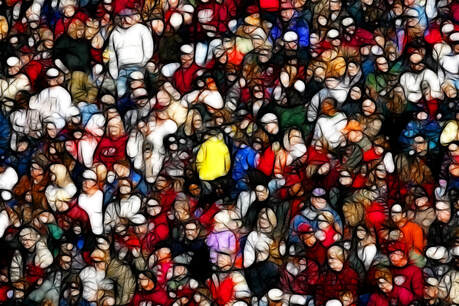Module 1100
Dynamic chemical equilibrium: An overview
What is the notion of dynamic chemical equilibrium?
In what sense is it dynamic?
How best to visualise dynamic equilibrium, at the levels of ions and molecules?
Does this topic have a jargon of its own, that must be understood?
An overview of the chapter
The condition of dynamic chemical equilibrium can be achieved when a reaction is reversible: there can be reaction to form the “products” as well as reaction to form the “reactants”.
If we refer to a generalized equation for a reversible reaction …
If we refer to a generalized equation for a reversible reaction …
this means that reaction of substances A and B (the “reactants”) to form the substances C and D (the “products”) happens at the same time that C and D react to form A and B.
“Reversibility” is indicated by the double arrow symbol in the chemical equation.
In a reaction mixture in the condition of dynamic chemical equilibrium, the concentrations of reactants and products (and, therefore, the properties of the reaction mixture) do not change as time passes – not because the reaction has gone to completion, nor because nothing is happening, but because reaction forming the “products” is happening at exactly the same rate (in moles per second) as is reaction to form the “reactants”.
Opposite and simultaneous reactions can be difficult to visualise. In Module 1101: Visualising dynamic chemical equilibrium, Prof Bob presents a novel way of trying to do so by focussing not on the two reactions, but on whatever is the object of competition that is transferred between substances as the reactions occur.
The always-important issue of language is especially significant in this topic because of the large number of terms that are used whose meaning is open to misunderstanding – or at least, ambiguity. These include the terms reactant, product, forward reaction direction, backward reaction direction, shifts to the right, net reaction, shifts to the left, and spontaneous direction of reaction.
In Module 1102 The jargon of chemical equilibrium Prof Bob promotes awareness of the meaning of these terms (and discourages their use as far as possible). We cannot use language terms to communicate meaning unless all of the participants of a conversation understand the terms in the same way.
By the way, you might like to see the post T0101 The jargon we use where issues of language beyond the topic of chemical equilibrium are brought into focus.
In Module 1102 The jargon of chemical equilibrium Prof Bob promotes awareness of the meaning of these terms (and discourages their use as far as possible). We cannot use language terms to communicate meaning unless all of the participants of a conversation understand the terms in the same way.
By the way, you might like to see the post T0101 The jargon we use where issues of language beyond the topic of chemical equilibrium are brought into focus.
Considering the concept of equilibrium quantitatively, it is rather remarkable that in all reaction mixtures (at the same temperature) in which a specified chemical reaction is at equilibrium, there is a particular mathematical expression of species concentrations that has the same numerical value – and this is not the case for any other function of their concentrations.
This paticular function of concentrations is called the reaction quotient (symbol Q). Its numerical value in reaction mixtures at equilibrium is called the equilibrium constant, K. Prof Bob and Elena conversationally clarify this relationship in Module 1103 Equilibrium constants: The law of equilibrium.
This paticular function of concentrations is called the reaction quotient (symbol Q). Its numerical value in reaction mixtures at equilibrium is called the equilibrium constant, K. Prof Bob and Elena conversationally clarify this relationship in Module 1103 Equilibrium constants: The law of equilibrium.
During reaction toward equilibrium the numerical value of Q changes, until equilibrium is achieved when the numerical value of Q is the same as the equilibrium constant appropriate for the temperature of the reaction mixture.
MORE COMING
MORE COMING
For discussions related to the teaching and learning (PCK) of the concept of dynamic chemical equilibrium, go to Teachers' Corner Chapter T11.
Finding your way around .....
You can browse or search the Aha! Learning chemistry website in the following ways:
You can browse or search the Aha! Learning chemistry website in the following ways:
- Use the drop-down menus from the buttons at the top of each page to browse the modules chapter-by-chapter.
- Click to go to the TABLE OF CONTENTS (also from the NAVIGATION button) to see all available chapters and modules in numbered sequence.
- Click to go to the ALPHABETICAL INDEX. (also from the NAVIGATION button).
- Enter a word or phrase in the Search box at the top of each page.




